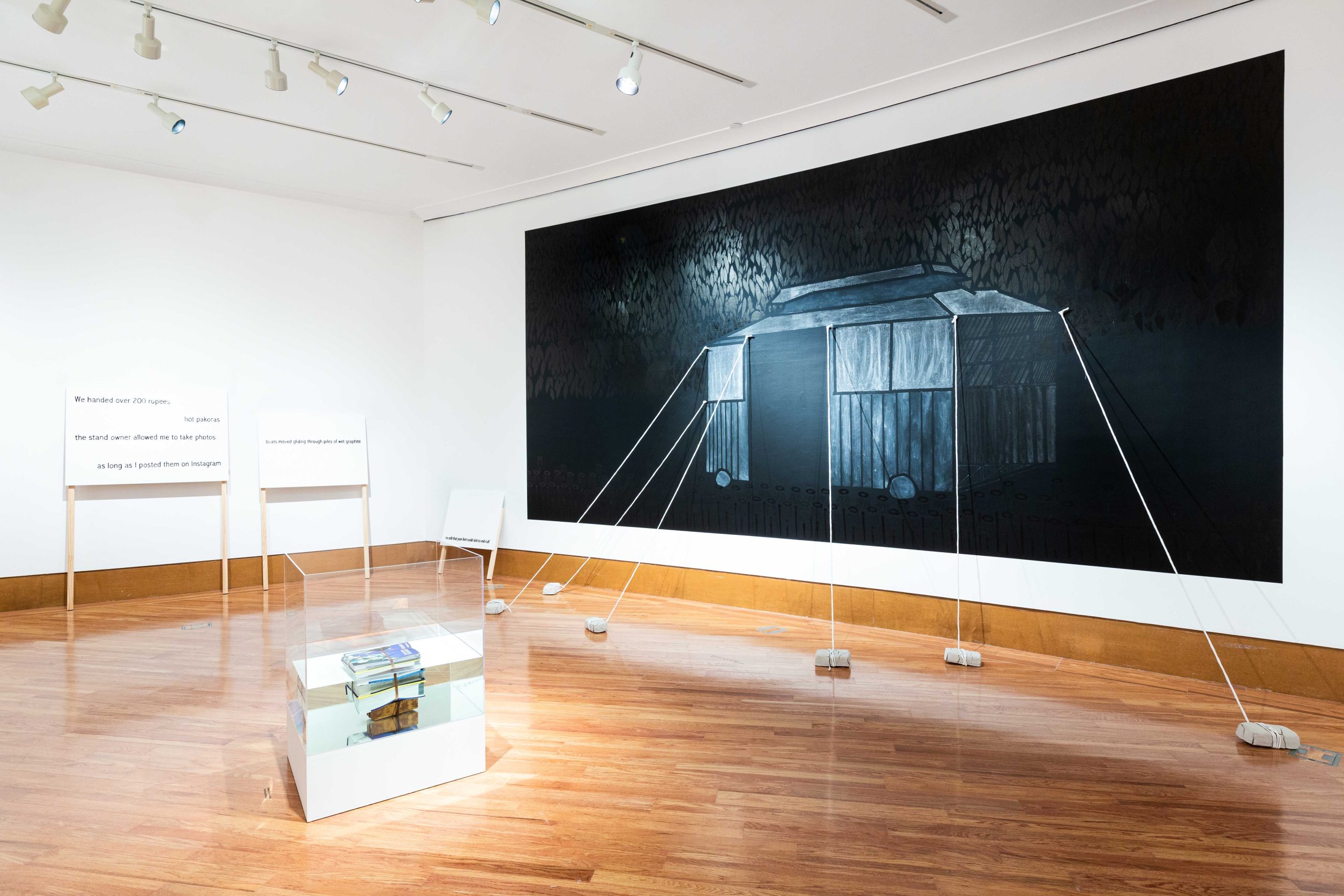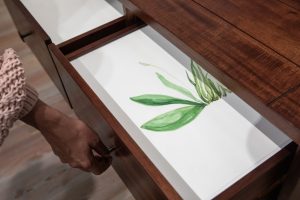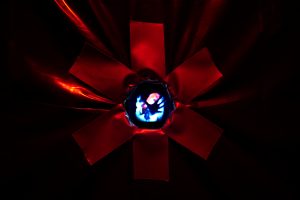Artist Sa’dia Rehman has had a busy couple of years and shows few signs of slowing down. The Columbus, Ohio-based artist, Queens native, and second-generation Pakistani-American has been in an intense process of research and production, making and boldly experimenting, sharing work, lecturing and doing so while shifting seamlessly between contexts. Since 2023, Rehman has been a tour-de-force engaging with universities, museums, and art spaces large and small across the US and internationally.
Rooted in drawing, Rehman’s practice flows between form and medium, between language and scale, effortlessly incorporating video, textile, print media, poetry, text, and other forms to expand expression and communication. Much of Rehman’s work looks to the past, unearthing and rearticulating the stakes of historic events (Rehman unsurprisingly worked for years as an archivist), though I am curious how this exhaustive historical research might one day open toward reconfigurations of the future. I’m certain Rehman could make one gorgeous Sci-Fi film. One thing is certain: the dense layers of their practice are only now beginning to unfold and shine. The years Rehman spent doing archival work, as an educator, managing other artists’ studios, are now paying off with well-deserved recognition for a highly resolved practice grounded in lived, embodied experience.
I had the pleasure of catching up with Rehman—my friend and former colleague—to discuss the project, which first kicked off the whirlwind tour: a solo exhibition, the river runs slow and deep and all the bones of my ancestors / have risen to the surface to knock and click like the sounds of trees in the air. The title comes from the poem My Aba’s Masjid by Bushra Rehman, the artist’s sister and frequent collaborator. This exhibition originated at the Wexner Center for the Arts (at Ohio State University) curated by Dionne Custer Edwards in collaboration with Kelly Kivland and Jennifer Lange, and subsequently traveled to the Patricia and Phillip Frost Art Museum (Miami) co-organized by Amy Galpin and Yady Rivero, between 2023-2024.
This ambitious exhibition, the river runs slow, comprises distinct works, which together form a larger cohesive installation. Graphite and ink find their home on paper, forming intimate drawings, and monumentally as a tactile mural marked across the gallery wall. Rehman’s experimentation expands with materials, hard and soft, from rusted rebar to charcoal and clay, lending a visual agility and play between objects. Quiet forms invite the viewer to engage with complex and demanding subjects like: environmental devastation caused by colonial projects, political and personal partition, the impossibility of translating cultural memory from one generation to another; the inescapability of grief.
While this traveling exhibition has come to a close, the subject matter and research continue to inform Rehman’s current work. These days they are exploring set design and awakening movement through collaborative projects with a dancer and a poet. “I’m being testy,” Rehman explains. In 2025, after a few pilot iterations, Rehman’s sights are set on working with architecture to develop a sound structural design for a mobile mosque, which would act as an actual and symbolic roving site of contemplation. Also, 2025 will be an important year for much-needed rest.
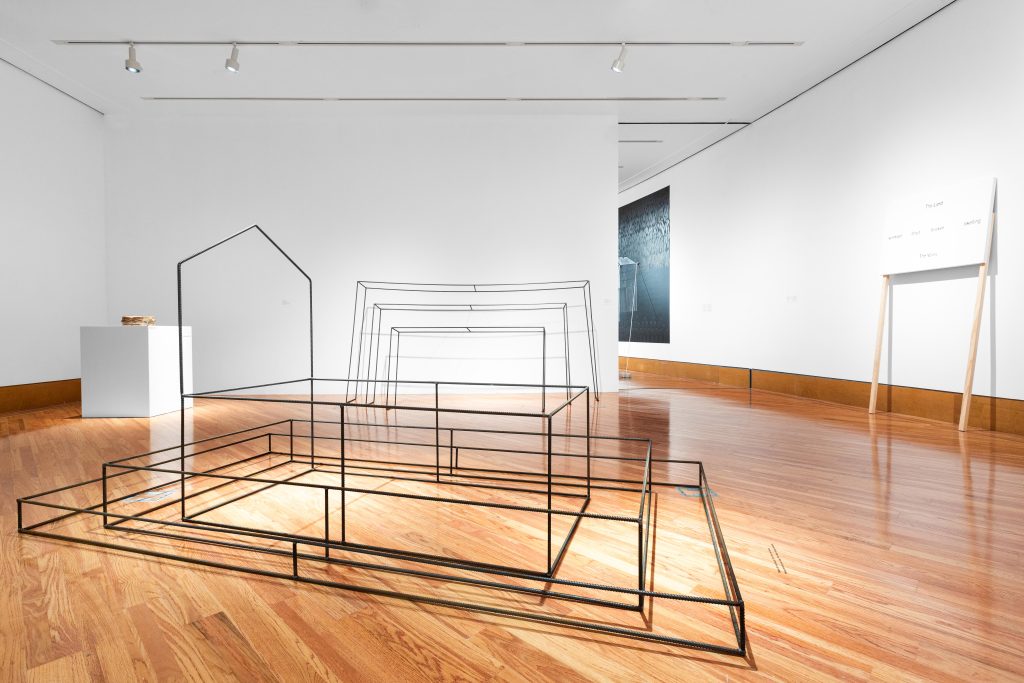
Megha Ralapati: Sa’dia, I’m happy to talk with you about the river runs slow, the project which in many ways initiated the current period of artistic engagement for you. Let’s start with the research process—you traveled to your father’s ancestral place, near the Indus River in Pakistan, which was famously home to the Tarbela Dam. The goal was to dig deeply into the history of the place. I see a relationship here between time and geography, which the project mines to unearth a fuller understanding of the present. Tell me about this journey and how did it mirror your own family’s displacement?
Sa’dia Rehman: My practice is research and intuition based. Family—the unit, the institution, the state, the nation, the world—is central to the conversations I am having in the studio. These are things I was born into, but often question and challenge, conceptually and formally through image and material. I choose materials that evoke loss, brokenness, fragments, and fragility.
The stories in my work fold into one another and nothing is revealed, even to me, until I continue the next work. I went to Pakistan in 2022 with my family. I have been to Pakistan multiple times as a child, but this time was different. My father knew I was curious about his childhood and our family’s forced migration because I was recording his stories months before we went to the Dam [in Pakistan]. The Tarbela Dam is one of the largest earth-filled dams in the world and it resides on the Indus River. The Dam regulates the water and generates electricity for a significant portion of Pakistan. The 1960s construction of this dam put 184 villages below water, not just my father’s. It permanently displaced 100,000 people, including my grandparents, uncles, aunts, and cousins. While reading about dam construction and interviewing family members, I started to see connections between colonialism, development, and displacement. Not just in Pakistan, but around the world.
My family’s displacement is not discussed within the family nor is there an official written record of it. While my parents were creating a home in the USA in the 1960s, their home in Khar Kot was being destroyed—a contradiction that I attempt to grapple with in my practice.
By conducting family interviews, sifting through the World Bank Archives, understanding debt and dam building (and now in the US, dam destruction), my practice has shifted, materially, but I continue to seek connections to grief, geography, and labor. When thinking through the work of tracing my family’s displacement, along with the many who are displaced globally in the name of modernization, privatization, militarization, I often think of this quote by writer, filmmaker, and theorist Aisha Ariella Azoulay: “The point is not giving voice to a silenced past and making the invisible visible, but releasing the past from its ‘pastness’ and letting it assume the vitality of what has always been there.” My family’s displacement is an unlived memory that I listen to through family oral storytelling. There is so much to reckon with. And I don’t think I’m in a place to even think about what the future of this place may be or become. It is beyond reconciliation; it is just transition. With climate precarity, the water will make its own decisions.
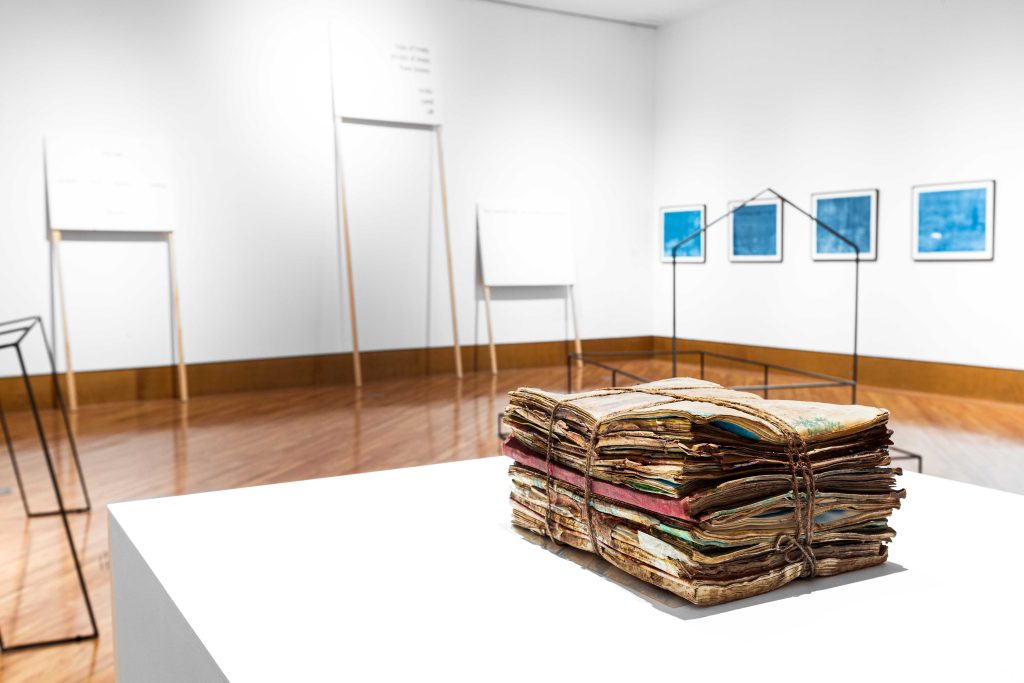
MR: I see a connection between this and a lived experience of toggling worlds and cultures, perhaps never quite finding firm footing on either ground. What do you think?
SR: I don’t see myself living between worlds or swimming in liminal space, although I do come from a long line of nomadic people and grew up in an anti-capitalistic home. Instead, the importance lay in faith, spirituality, and peace with the soul. Stepping out of my family home into a pivotal point of capitalism in 1980s USA was like straddling two worlds. I have yet to resolve these contradictions, but I don’t mind it being a slow process.
I think here it’s important to mention [my] series The Alphabet of Grief, 2022 because in this set of monoprints I attempted to connect memory and imagination. In some ways that is what it takes to toggle between worlds. For the monoprints, I drew lines making up what I had seen on the Indus River—broken mosques, cracked gravestones, boats, destroyed homes. But at the same time there were moments of life, hope, repair. To create the monoprint series, I made several batches of a mix of blue, green, and brown water-based printmaking ink. I used the mixture to ink and cover a large acetate plate. Drawing on the plate required scratching the ink away into fragmented worlds. After I finished drawing on each plate, I laid a dampened paper on top and pressed the plate and paper through a printmaking roller. The process mirrors multiple layers of the loss of structures, homes, and ancestral land.
MR: Across the project, there’s a beautiful play between dream and reality, fiction and the narration of fact through word or mark-making. Your large-scale wall mural almost reads like a history painting, in which you play with narrative and legibility. How do you relate to the space between real and imagined?
SR: I think we need imagination to survive and to build a different world. I attempt to do this throughout the exhibition. Firstly, with the title—poetry is an act of imagination. Bushra wrote the poem My Aba’s Masjid in 2013. In the poem she imagined what happened to my grandfather’s mosque; how the floodgates were opened by government employees, how the mosque drowned, and how he watched it until the tip of the minaret was no longer. Just describing it in this way sounds fantastical, but it did happen.
Protest is an act of imagination, an act of will. Stencils have long been part of my art practice. The stencil as a sculpture marks protest. Stencils are tools of replication. They are guidelines. They can be broken. They are viewfinders. Stencils can create borders and walls. They can also create containers or modes of collectivity, numbers, safety. I use stencils in my wall drawings. Over time, the wall drawing interacts with the elements—air, light, the space—and morphs into a life itself, a body, transforming, resisting, and persisting.
For [my piece] The Raft [displayed] at the Wexner Center, I wanted to reimagine Théodore Géricault’s The Raft of the Medusa. Gericault’s enigmatic large-scale painting depicts a shipwreck where death and hope live on the same surface. The composition plays with perspective, where the viewer’s eye wanders in and out of two of the highest points in the painting: the flowing sail and a survivor waving white fabric. I adapted the brokenness of the raft and added floating mosque domes, a row of electricity poles. The sail was replaced by a tethered tent, the drowning survivors with people swimming and holding water jugs. The mixed textures, markings, and materials hover on the gallery walls and reference history, memory, and archiving.
In February 2024, I created a different wall drawing at the Frost Art Museum, also titled The Raft. This time I replaced the broken raft with a shambolic structure on wheels, which sat in an overflowing grove of mango trees and a lush field of poppies. The drawing of a pagoda-like form on wheels was a mosque I saw on the Indus in 2022. It was an artifact from the future, embodying an index of place and signaling the memory of geological time. For the past year, I drew the mobile mosque on walls, built gauze maquettes, and made life-size mockups. This study of architecture, mobility and gathering has become central to the work right now.
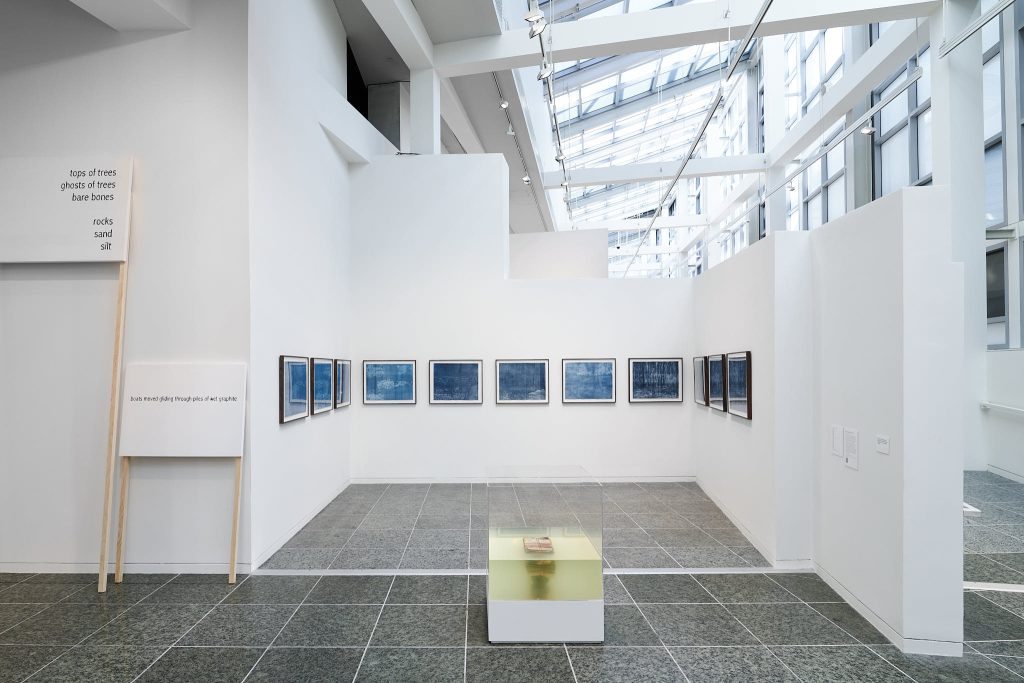
MR: Let’s talk about the varied materials you used for the exhibition the river runs slow at the Wex, which includes architectural forms created from rebar, indigo dyed textiles, works on paper, text paintings, and the mural we discussed. There’s also an arresting work titled Burn it, Bury it, Drown it: a stack of Urdu primers, which becomes a sculpture, bound and submerged in water. There are so many fascinating material experiments for you here. What challenged you the most between concept and realization?
SR: Yes! Materials—a favorite topic! I never worked with water [previously], even though my entire body of work deals with the immensity of water. Similar to The Raft, I had no idea what was going to happen with Burn it, Bury it, Drown it. With The Raft, there were elements that changed over time. I drew with Ohio-clay directly on the wall. That clay dried, cracked, and peeled off the wall, falling to the floor. Burn it, Bury it, Drown it was composed of a stack of my childhood Urdu primers in a clear basin partially filled with water. As formal early learning texts, the primers contain stories, morality teachings, drawings, poetry, and lessons in Urdu, an official language of Pakistan. It is not the language that my family speaks—they speak Pashto and Hindko. Submerged in water, the books evoke burial, submission, and loss. Over time, the water in the vitrine turned a brown color as the ink shed into water and the paper weakened. The bound Urdu books emerged from the water as it evaporated. Throughout the exhibition there are formal, aesthetic, and visceral relationships of submergence and emergence.
The bound books as material have become an ongoing series. The first version of Burn it, Bury it, Drown it—or the Urdu primers—has now become a ruin, reference, artifact. At the Frost Art Museum, the books, now a hardened block, were displayed on a pedestal. [For this recent iteration], I submerged US history textbooks discarded by a local Miami school. The work now spoke to layers and layers of untold histories and [how] yet again these histories [were] being erased by the state, the law, and specifically led by Florida governor Ron DeSantis. There is a third iteration on display in my most recent solo show, Water/Bodies, curated by Azra Dawood and on view at The Loeb in Poughkeepsie, NY until August 2025. Here, I submerge a copy of the 1979 2nd edition of Webster’s New Twentieth Century Dictionary. This 2100-page dictionary was the first and only dictionary my father purchased to assimilate into an American-English society.
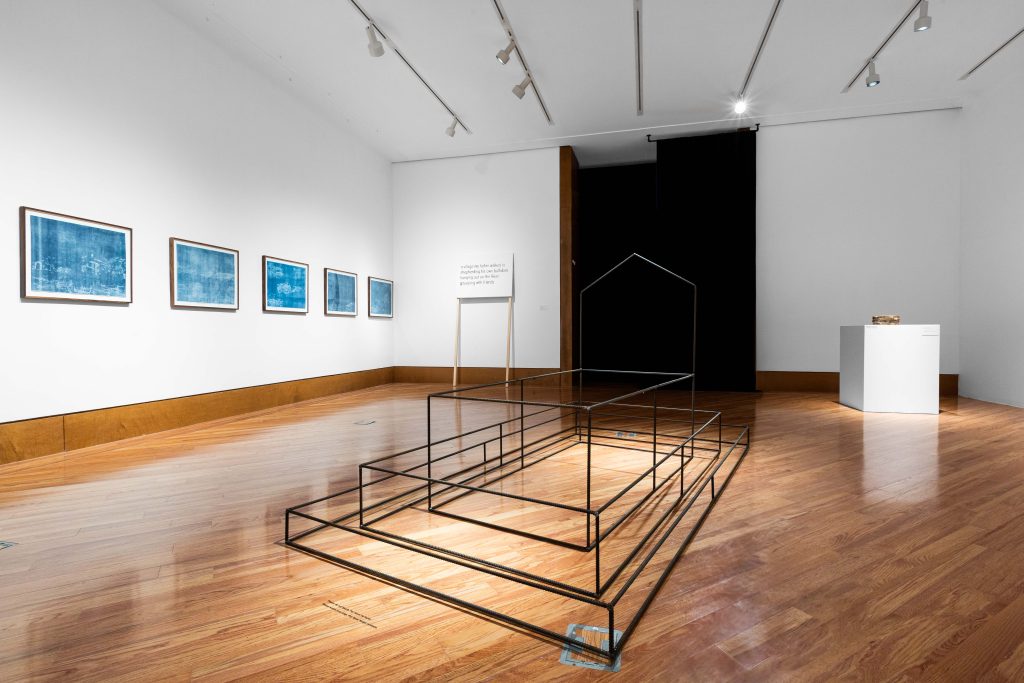
MR: The two-channel video work There isn’t a stone I don’t remember (2022) is a kind of legend to the exhibition—it depicts a number of slow, striking images of the environment: a hail storm which delights your nieces and nephews, a water reservoir juxtaposed with a barren river bed, and a shot of syrupy mud. It’s one of the few times we feel the perspective of the artist; your hand reaching out to grasp the wet mud. These granular experiences of the earth are politically-charged yet have a quiet sensibility in your handling. Yet, the environmental crisis impacting this terrain is anything but subtle. How do you reconcile this?
SR: My current project more squarely engages with the environment. But I, like so many other people, am now realizing that questions of the environment, environmental justice, and disaster are all around us. And these questions are ones that we all need to think about and must be central to all the movements of our time. Including those around, about, and through art.
The video is part documentary, part sublime. The work follows several family members—adults and children—as they wade, play, and make a pilgrimage for the first time to the site [where] their parents and ancestors were displaced. I wanted the video to loop and also be displayed as an open book. This allowed a cyclical revisitation of this space. What does it mean to go back to the place of displacement? Confront the history, possibly retelling the story? Using personalized symbologies, documentation, architecture and landscape, ritual, and sound, I reveal and memorialize suppressed histories while offering alternative understandings of the present.
Showing the children’s excitement with the hail and the storm, and then the shot of my cousins’ children running on the dried land that is usually filled with river, was something I wanted to show because of its contradictions. Even though the environment is a new kind of focus in the work, harm and survival are themes that go back in my work from the beginning. In my earlier work, I was interested in harm and survival in the home, or as a queer person of color navigating white spaces. Over time, I have thought about harm and survival in different contexts. Environmental disaster poses existential threats and that is quite scary. The primary violence I’m concerned with is the violence of the corporations that are fueling extractivism and harvesting fossil fuels for their own profits—without little concern for humans, animals, and other forms of life on earth. I am also concerned with how, in the face of climate disaster, the state deploys police to repress rebellion. We saw this of course in 2020 when the state could not muster a meaningful response to the global COVID pandemic but deployed countless police and military to repress the largest protests in the country’s history. And we have seen it in the protests happening across university campuses against the genocide of the Palestinian people.
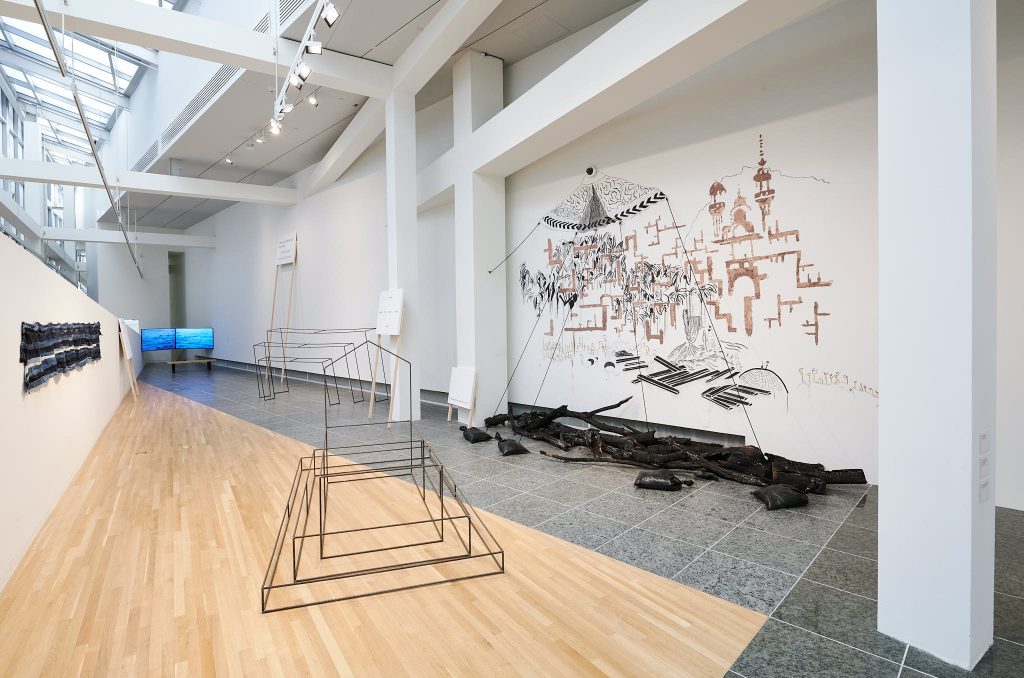
SR: Antonio Gramsci talked of the importance of having pessimism of the intellect and optimism of the will— meaning, being able to see the sober and urgent conditions around us. People are dying and suffering all around us in so many needless ways, and there are so many people who are unwilling or uninterested in making any real change. And at the same time, [we are] able to commit to taking on work with others, to persist in our commitment to each other, to better futures. Mariame Kaba talks about hope as a discipline. I am working on that through my art practice. In other words, to see the world as it really is, warts and all, but still forge ahead with courage, tenacity, persistence, and acceptance. The will can overcome many challenges if hope remains alive.
MS: Thank you for taking the time to chat with me about this project. I have fond memories working with you over a decade ago when I was Gallery Director and you were Archivist who also moonlighted as DJ Rekha and Chitra Ganesh’s studio manager. I can’t help but see traces of that work in your practice today, especially your commitment to keeping an archive of a living entity that demands engagement.
SR: And I’m thrilled to continue our conversations about my practice and this project. Yes, I think the multiple part-time jobs I held also speaks to me dabbling in the transdisciplinary. My mentors are also my collaborators where we collectively define and reimagine the world we live in as visual thinkers. Thank you for being a part of that circle.
* * *
the river runs slow and deep and all the bones of my ancestors / have risen to the surface to knock and click like the sounds of trees in the air was on view at Wexner Center for the Arts, Columbus, Ohio February 5th – July 9th, 2023.
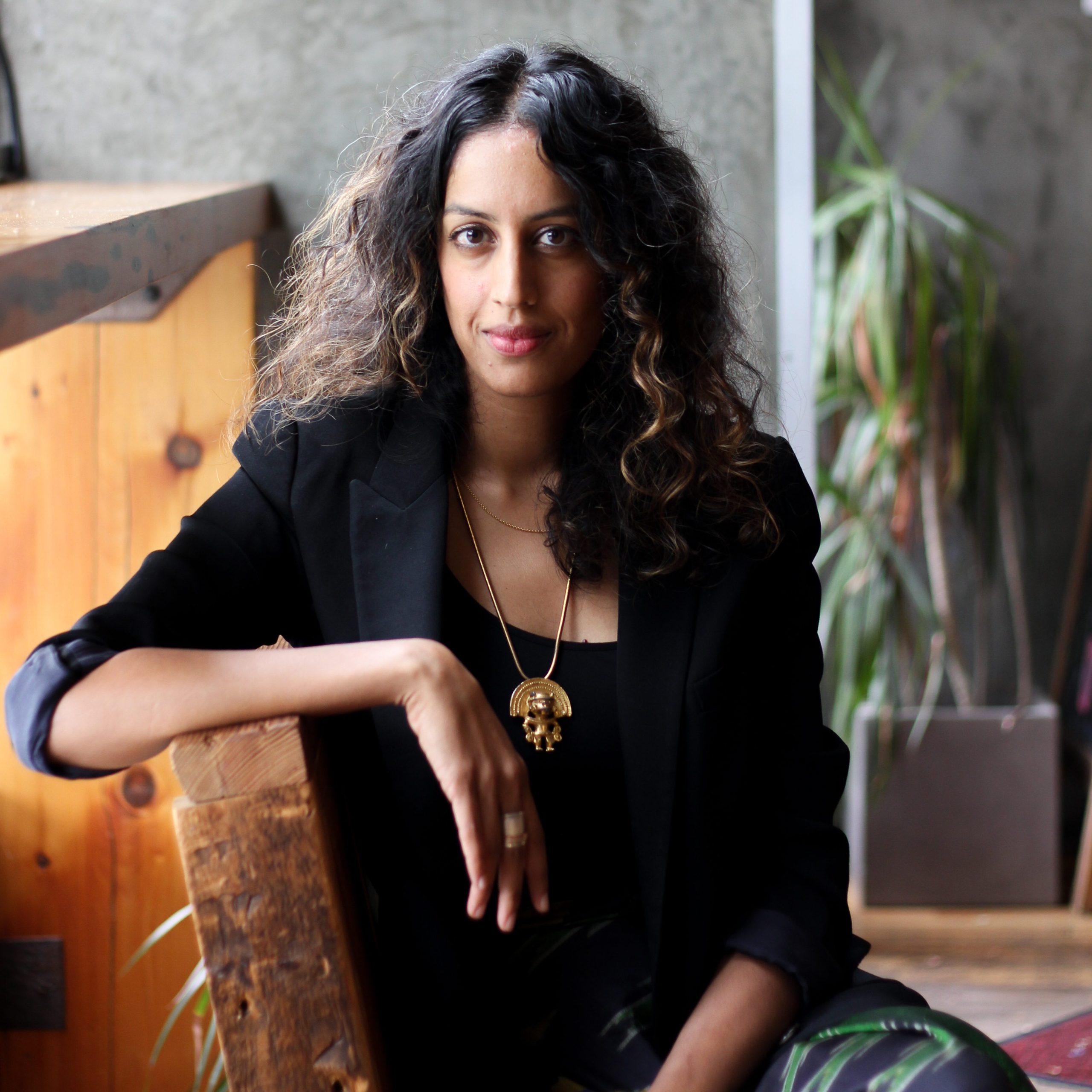
About the Author: Megha Ralapati is an independent curator and arts leader in Chicago who has written for various publications, including for Documenta 14, Brooklyn Museum, Sharjah Art Foundation, n+1, and the Devi Art Foundation, among others. She is a board member of Artist Communities Alliance, Enrich Chicago, The Centre for Contemporary Art in Lagos, and is a member of SpaceShift, an interdisciplinary art collective. Photo credit: zakkiyyah najeebah dumas-o’neal.
